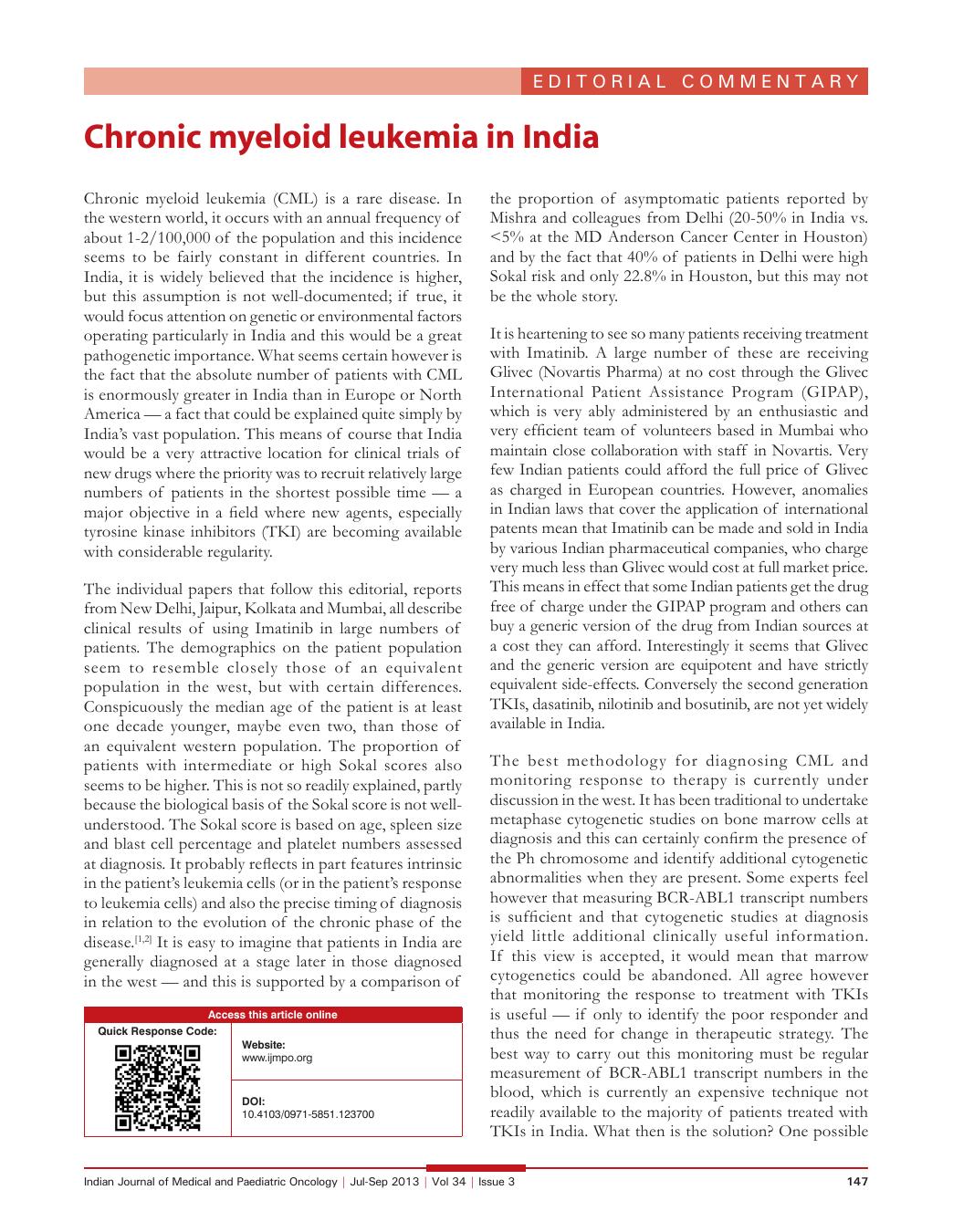Chronic myeloid leukemia in India
CC BY-NC-ND 4.0 · Indian J Med Paediatr Oncol 2013; 34(03): 147-148
DOI: DOI: 10.4103/0971-5851.123700

Publication History
Article published online:
19 July 2021
© 2013. Indian Society of Medical and Paediatric Oncology. This is an open access article published by Thieme under the terms of the Creative Commons Attribution-NonDerivative-NonCommercial-License, permitting copying and reproduction so long as the original work is given appropriate credit. Contents may not be used for commercial purposes, or adapted, remixed, transformed or built upon. (https://creativecommons.org/licenses/by-nc-nd/4.0/.)
Thieme Medical and Scientific Publishers Pvt. Ltd.
A-12, 2nd Floor, Sector 2, Noida-201301 UP, India
Chronic myeloid leukemia (CML) is a rare disease. In the western world, it occurs with an annual frequency of about 1-2/100,000 of the population and this incidence seems to be fairly constant in different countries. In India, it is widely believed that the incidence is higher, but this assumption is not well-documented; if true, it would focus attention on genetic or environmental factors operating particularly in India and this would be a great pathogenetic importance. What seems certain however is the fact that the absolute number of patients with CML is enormously greater in India than in Europe or North America — a fact that could be explained quite simply by India's vast population. This means of course that India would be a very attractive location for clinical trials of new drugs where the priority was to recruit relatively large numbers of patients in the shortest possible time — a major objective in a field where new agents, especially tyrosine kinase inhibitors (TKI) are becoming available with considerable regularity.
The individual papers that follow this editorial, reports from New Delhi, Jaipur, Kolkata and Mumbai, all describe clinical results of using Imatinib in large numbers of patients. The demographics on the patient population seem to resemble closely those of an equivalent population in the west, but with certain differences. Conspicuously the median age of the patient is at least one decade younger, maybe even two, than those of an equivalent western population. The proportion of patients with intermediate or high Sokal scores also seems to be higher. This is not so readily explained, partly because the biological basis of the Sokal score is not well-understood. The Sokal score is based on age, spleen size and blast cell percentage and platelet numbers assessed at diagnosis. It probably reflects in part features intrinsic in the patient's leukemia cells (or in the patient's response to leukemia cells) and also the precise timing of diagnosis in relation to the evolution of the chronic phase of the disease.[1,2] It is easy to imagine that patients in India are generally diagnosed at a stage later in those diagnosed in the west — and this is supported by a comparison of the proportion of asymptomatic patients reported by Mishra and colleagues from Delhi (20-50% in India vs. <5>
It is heartening to see so many patients receiving treatment with Imatinib. A large number of these are receiving Glivec (Novartis Pharma) at no cost through the Glivec International Patient Assistance Program (GIPAP), which is very ably administered by an enthusiastic and very efficient team of volunteers based in Mumbai who maintain close collaboration with staff in Novartis. Very few Indian patients could afford the full price of Glivec as charged in European countries. However, anomalies in Indian laws that cover the application of international patents mean that Imatinib can be made and sold in India by various Indian pharmaceutical companies, who charge very much less than Glivec would cost at full market price. This means in effect that some Indian patients get the drug free of charge under the GIPAP program and others can buy a generic version of the drug from Indian sources at a cost they can afford. Interestingly it seems that Glivec and the generic version are equipotent and have strictly equivalent side-effects. Conversely the second generation TKIs, dasatinib, nilotinib and bosutinib, are not yet widely available in India.
The best methodology for diagnosing CML and monitoring response to therapy is currently under discussion in the west. It has been traditional to undertake metaphase cytogenetic studies on bone marrow cells at diagnosis and this can certainly confirm the presence of the Ph chromosome and identify additional cytogenetic abnormalities when they are present. Some experts feel however that measuring BCR-ABL1 transcript numbers is sufficient and that cytogenetic studies at diagnosis yield little additional clinically useful information. If this view is accepted, it would mean that marrow cytogenetics could be abandoned. All agree however that monitoring the response to treatment with TKIs is useful — if only to identify the poor responder and thus the need for change in therapeutic strategy. The best way to carry out this monitoring must be regular measurement of BCR-ABL1 transcript numbers in the blood, which is currently an expensive technique not readily available to the majority of patients treated with TKIs in India. What then is the solution? One possible answer would be the implementation of the ambitious but by no means unrealistic target of the International CML Foundation to make the methodology for monitoring more readily available in collaboration with the Novartis and the Cepheid Company in California. Cepheid makes a cartridge that measures BCR-ABL1 transcript numbers with great reliability in just a few hours. The basic equipment is expensive but it has many other possible uses, including diagnosis of drug resistant tuberculosis and measurement of human immunodeficiency virus copy numbers, so the purchase price is more readily justified. The cartridge itself is disposable and could eventually be quite cheap. It is hoped that methodology for monitoring transcript numbers could become widely available in India within the next few years.
Clearly more detailed evaluation of newly diagnosed patients in India could be very informative. A national registry would go far to answer establish the incidence of CML and could provide other information of great value.
Footnotes
Source of Support: Nil.
Conflict of Interest: None declared.


 PDF
PDF  Views
Views  Share
Share

